

The Ultimate PC Build for Photography Needs - Skylake Edition. It has been a while since I published my first article on an Ultimate PC Build for Photography Needs.
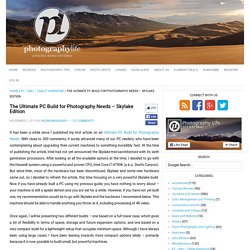
With close to 300 comments, it surely attracted many of our PC readers, who have been contemplating about upgrading their current machines to something incredibly fast. At the time of publishing the article, Intel had not yet announced the Skylake microarchitecture with its sixth generation processors. After looking at all the available options at the time, I decided to go with the Haswell system using a powerful and proven CPU, Intel Core i7-4790K (a.k.a. Understanding & Using Ansel Adam's Zone System. The Zone System is a technique that was formulated by Ansel Adams and Fred Archer back in the 1930's.

It is an approach to a standardized way of working that guarantees a correct exposure in every situation, even in the trickiest lighting conditions such as back lighting, extreme difference between light and shadow areas of a scene, and many similar conditions that are most likely going to throw off your camera's metering giving you a completely incorrect exposure. Today we're going to explore this system, and investigate how it can help you with your photography! Republished Tutorial Every few weeks, we revisit some of our reader's favorite posts from throughout the history of the site. This tutorial was first published in February of 2011. Your camera's metering modes are built to give you a correct reading under most average situations.
Sensor Size, Perspective and Depth of Field. A few months ago we wrote an extensive article on sensor crop factors and equivalence.

In that post we covered several topics: the history of the cropped-sensor formats, brightness of the scene, perspective, depth of field, noise and diffraction. Getting Ready for My 11/4 NYC Model Shoot: Six Days of Speedlite Tips - in one post — Rick Sammon Photography. We all know the problem: You're on a location and everything goes as planned.
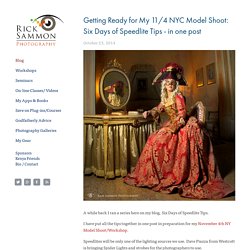
You shoot the stuff your client wants and you all go home happy. But how often does it happen that afterward, your client says something like, "You know, the look is great but . . . . " Well, the following tip will make sure that this problem is solved before it happens. It may also give you more revenue from your shoots. When shooting on location, always make sure that you deliver two series of pictures: one with speedlites and one with only the natural light. How to expose to the right: understand the theory and practice. Discover how to expose to the right and why photographers might want to use this advanced technique.
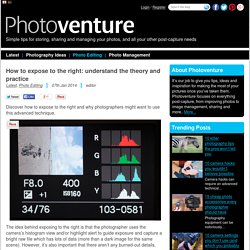
The idea behind exposing to the right is that the photographer uses the camera’s histogram view and/or highlight alert to guide exposure and capture a bright raw file which has lots of data (more than a dark image for the same scene). However, it’s also important that there aren’t any burned-out details. Getting started with 500px - Jason Waltman Photography. By jason on | 50 Comments 500px is an online photo sharing community.

It’s similar to the popular website flickr, but designed by photographers, for photographers to share only their best work. 500px has about 500 times fewer registered users than flickr—but in my opinion, that’s a good thing. The site has a unique rating system that’s time sensitive. This means that no matter how well known you are your photos’ “pulse” will go down over time; everyday new photos have a chance to make it to the top and be seen by hundreds of thousands of viewers. After browsing 500px for a while I decided to register a few months ago. The rating system. The thing that makes 500px unique over other photo sharing sites is its time and popularity-based rating system. Blog / Tutorial: Time Stack. Today I’d like to introduce the brilliant Matt Molloy, photography enthusiast and budding professional.

He’s the author of those amazing impressionist inspired photos. So many people have asked how to do this technique, and he’s been gracious enough to share it here with us! Please enjoy this Time Stack Tutorial. New Camera and Photography Articles, Nikon DSLR camera and lens. 99 Common Photography Problems (and how to solve them) As well as being one of the most expensive hobbies around, photography is also one of the more technical pastimes you can pursue.
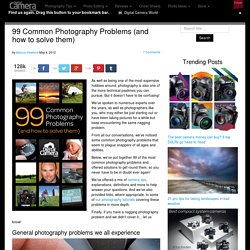
But it doesn’t have to be confusing! We’ve spoken to numerous experts over the years, as well as photographers like you, who may either be just starting out or have been taking pictures for a while but keep encountering the same nagging problem. SmallGantics - Bent Image Lab. Earlier this year I was introduced to the captivating aerial photography of Olivo Barbieri via a web link sent by a long-time friend and professional photographer.
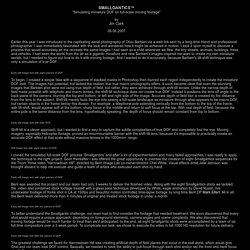
I was immediately fascinated with the look and wondered how it might be achieved in motion. I took it upon myself to discover a process that would accurately let me recreate the same images I had seen as a child whenever we flew: the tiny streets, animals, buildings, trees and vehicles. How to expose to the right: understand the theory and practice. Debunking the myth that focal length affects perspective + how to actually do it. In this tutorial we show you how to take charge of perspective by using different viewpoints and camera angles to radically alter the look and feel of your images.

It’s often said that lenses change the perspective of your shots, with wide-angle lenses exaggerating perspective and telephoto lenses compressing it. That’s not actually the case. While it’s true that you need to change the focal length of your lens to achieve different types of images, the lens doesn’t actually affect the perspective of your images. All the lens does is determine how much, or little, of the subject you include in your image. Digital Camera Sensor Sizes: How it Influences Your Photography.
This article aims to address the question: how does your digital camera's sensor size influence different types of photography? Your choice of sensor size is analogous to choosing between 35 mm, medium format and large format film cameras — with a few notable differences unique to digital technology. Much confusion often arises on this topic because there are both so many different size options, and so many trade-offs relating to depth of field, image noise, diffraction, cost and size/weight. Background reading on this topic can be found in the tutorial on digital camera sensors. Sensor sizes currently have many possibilities, depending on their use, price point and desired portability.
The relative size for many of these is shown below: Canon's 1Ds/5D and Nikon D3 series are the most common full frame sensors. Camera phones and other compact cameras use sensor sizes in the range of ~1/4" to 2/3". The crop factor is the sensor's diagonal size compared to a full-frame 35 mm sensor.